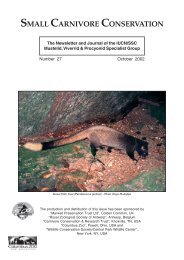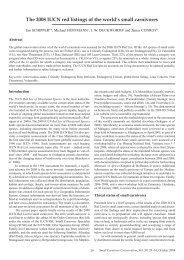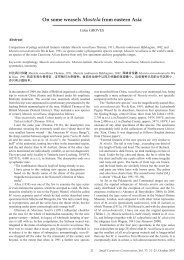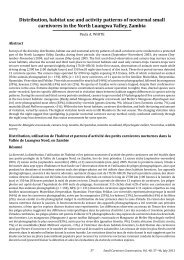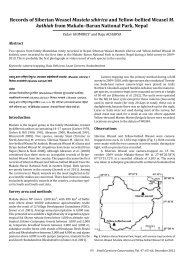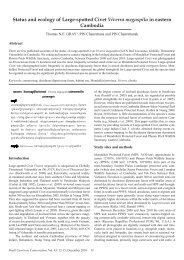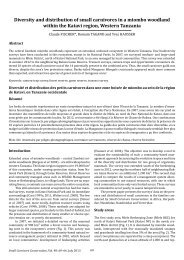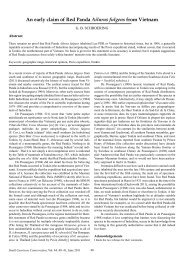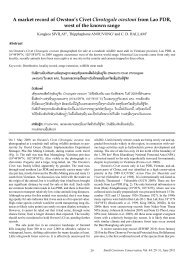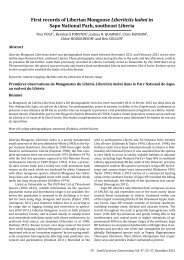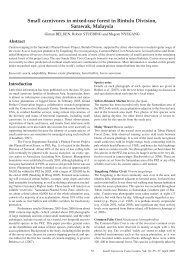The conservation status of small carnivores in the Americas
The conservation status of small carnivores in the Americas
The conservation status of small carnivores in the Americas
Create successful ePaper yourself
Turn your PDF publications into a flip-book with our unique Google optimized e-Paper software.
<strong>The</strong> <strong>conservation</strong> <strong>status</strong> <strong>of</strong> <strong>small</strong> <strong>carnivores</strong> <strong>in</strong> <strong>the</strong> <strong>Americas</strong>Jerrold L. BELANT 1 *, Jan SCHIPPER 2,3 and James CONROY 4AbstractGlobal <strong>conservation</strong> <strong>status</strong> <strong>of</strong> <strong>small</strong> <strong>carnivores</strong> with geographic range <strong>in</strong> <strong>the</strong> <strong>Americas</strong> was assessed us<strong>in</strong>g <strong>the</strong> 2008 IUCN Red List.Small <strong>carnivores</strong> as categorised by IUCN, <strong>in</strong>clud<strong>in</strong>g otters, <strong>in</strong> <strong>the</strong> <strong>Americas</strong> represent about 26% <strong>of</strong> <strong>the</strong> extant <strong>small</strong> <strong>carnivores</strong> worldwide.Familial diversity is low, with only three <strong>of</strong> <strong>the</strong> world’s n<strong>in</strong>e families (Mephitidae, Mustelidae and Procyonidae) represented.Greatest species richness occurred <strong>in</strong> Central America, <strong>the</strong> Andes Mounta<strong>in</strong>s, and <strong>the</strong> west coast <strong>of</strong> <strong>the</strong> United States <strong>of</strong> America. Of <strong>the</strong><strong>small</strong> carnivore species currently evaluated on <strong>the</strong> global 2008 IUCN Red List <strong>of</strong> Threatened Species, 46 are native to <strong>the</strong> <strong>Americas</strong> (43endemic), one is Ext<strong>in</strong>ct (EX), six are Endangered (EN), two are Vulnerable (VU), one is Near Threatened (NT), 31 are Least Concern(LC), and five are Data Deficient (DD). Cozumel Coati Nasua nelsoni and Eastern Mounta<strong>in</strong> Coati Nasuella meridensis are excludedfrom <strong>the</strong>se analyses because <strong>the</strong>ir taxonomy was modified after <strong>the</strong> 2008 IUCN Red List <strong>of</strong> Threatened Species. No <strong>small</strong> carnivore species<strong>of</strong> <strong>the</strong> <strong>Americas</strong> are currently listed as Critically Endangered (CR) or Ext<strong>in</strong>ct <strong>in</strong> <strong>the</strong> Wild (EW). Thus, for extant species with dataadequate to assign a <strong>status</strong>, 20% were considered globally threatened (i.e. CR, EN or VU), primarily a result <strong>of</strong> four <strong>of</strong> <strong>the</strong> region’s fiveotter species be<strong>in</strong>g categorised as Endangered. <strong>The</strong> exact threat level is unknown, but is between 18% (if no Data-Deficient species isthreatened) and 29% (if all are). Global populations are estimated to be decl<strong>in</strong><strong>in</strong>g for 62% <strong>of</strong> carnivore species with adequate data andstable for 29%; only 9% <strong>of</strong> <strong>small</strong> carnivore species populations are estimated to be <strong>in</strong>creas<strong>in</strong>g. <strong>The</strong> five (11%) categorisations as DD are<strong>in</strong> part a consequence <strong>of</strong> recent taxonomic revision. Although overall <strong>conservation</strong> <strong>status</strong> <strong>of</strong> <strong>small</strong> <strong>carnivores</strong> <strong>in</strong> <strong>the</strong> <strong>Americas</strong> comparesfavourably with mammals worldwide, decl<strong>in</strong><strong>in</strong>g populations <strong>of</strong> many species and exist<strong>in</strong>g and new threats (e.g. climate change) suggestthat additional <strong>small</strong> carnivore species may become threatened unless effective <strong>conservation</strong> strategies are implemented.Keywords: <strong>conservation</strong> <strong>status</strong>, Data Deficient, Endangered, IUCN Red List, Least Concern, Mephitidae, Mustelidae, Procyonidae, speciesrichness, Near Threatened, threatened, VulnerableEstado de conservación de los pequeños carnívoros en las AméricasResumenEl estado de conservación global de las especies de pequeños carnívoros, cuyos ámbitos geográficos <strong>in</strong>cluyen las Américas, fueronevaluados usando la Lista Roja de UICN de 2008. Los pequeños carnívoros de las Américas representan cerca del 28% de los pequeñoscarnívoros vivientes a nivel mundial. S<strong>in</strong> embargo, la diversidad de familias es baja, representado por solo 3 de 9 familias (Mephitidae,Mustelidae y Procyonidae). Las mayores riquezas de especies ocurren en Centro América, los Andes, y la costa oeste de Estado Unidos.De las 46 especies de pequeños carnívoros nativos de las Américas (43 endémicas), una esta ext<strong>in</strong>ta (EX), seis están Amenazadas (EN),dos son Vulnerables (VU), una es Casi Amenazada (NT), 31 de Baja Preocupación (LC) y c<strong>in</strong>co fueron consideradas Deficientes deDatos (DD) en térm<strong>in</strong>os de las evaluaciones de Lista Roja. No <strong>in</strong>cluimos el Coati de Cozumel Nasua nelsoni y el Coatí de Montañadel Este Nasuella meridensis ya que su taxonomía fue modificada posterior a la Lista Roja de UICN 2008. N<strong>in</strong>guna especie fue listadacomo Críticamente Amenazada (CR) o Ext<strong>in</strong>ta en la Naturaleza (EW). Para las especies con datos adecuados para asignarles unacategoría, 20% fueron considerados globalmente amenazados (ej. CR, EN o VU), pr<strong>in</strong>cipalmente como resultado de que cuatro de lasc<strong>in</strong>co especies de nutrias de la región fueron consideradas Amenazadas. Las estimaciones globales de poblaciones fueron consideradasen declive para el 62% de las especies con datos adecuados, 29% fueron considerados estables y solo el 9% fueron considerados enaumento. C<strong>in</strong>co especies (11%) fueron consideradas DD, en parte debido a su reciente revisión taxonómica. A pesar de que el estadode conservación general de los pequeños carnívoros de las Américas es favorable comparado con los mamíferos a nivel mundial, elestado general de poblaciones en declive y la presencia de nuevas amenazas (ej. cambio climático) y aquellas que previamente existían,sugieren que más especies de pequeños carnívoros pueden convertirse en amenazadas a menos que estrategias de conservación efectivassean implementadas.Palabras clave: amenaza, Amenazada, Baja Preocupación, Casi Amenazada, Deficiente de Datos, estado de conservación, Lista Roja deUICN, Mephitidae, Mustelidae, Procyonidae, riqueza de especies, VulnerableIntroductionSmall <strong>carnivores</strong> play important roles <strong>in</strong> ecosystem function (e.g.seed dispersal), predator–prey dynamics, and <strong>in</strong> relation to people(e.g. hunt<strong>in</strong>g, disease; Graham & Lamb<strong>in</strong> 2002, LoGiudice& Ostfeld 2002, Sterner et al. 2008). Similarly, a wide variety<strong>of</strong> anthropogenic threats (e.g. climate change, harvest, habitatloss and fragmentation) demonstrably effect <strong>small</strong> carnivore speciesadversely (Carroll 2007, Koen et al. 2007, Med<strong>in</strong>a-Vogel etal. 2007a). Numerous studies have assessed <strong>the</strong> effects <strong>of</strong> <strong>the</strong>sethreats on mammalian species, <strong>in</strong>clud<strong>in</strong>g <strong>small</strong> <strong>carnivores</strong> (Hargiset al. 1999, Carroll et al. 2003, Whiteman et al. 2007). <strong>The</strong> global<strong>conservation</strong> <strong>status</strong> <strong>of</strong> all mammals worldwide was assessed for<strong>the</strong> 2008 IUCN Red List <strong>of</strong> Threatened Species (Schipper et al.2008b) and results were summarised for <strong>small</strong> <strong>carnivores</strong> world-3Small Carnivore Conservation, Vol. 41: 3–8, August 2009
Status <strong>of</strong> <strong>small</strong> <strong>carnivores</strong> <strong>in</strong> <strong>Americas</strong>cient (DD) (Fig. 2). No carnivore species were listed as CriticallyEndangered (CR) or Ext<strong>in</strong>ct <strong>in</strong> <strong>the</strong> Wild (EW). For those extantcarnivore species with adequate data to assign a <strong>status</strong> (n = 40),20% were considered globally threatened (i.e. CR, EN or VU).<strong>The</strong> exact threat level for <strong>small</strong> carnivore species lies between18% (assum<strong>in</strong>g no Data-Deficient species threatened) and 29%(assum<strong>in</strong>g all Data-Deficient species threatened).Of <strong>the</strong> eight species considered globally threatened, five (SeaOtter Enhydra lutra, Mar<strong>in</strong>e Otter Lontra fel<strong>in</strong>a, Sou<strong>the</strong>rn RiverOtter Lontra provocax, Giant Otter Pteronura brasiliensis andPygmy Spotted Skunk Spilogale pygmaea) were listed us<strong>in</strong>g <strong>the</strong>A Criterion (population decl<strong>in</strong>e), two (Colombian Weasel Mustelafelipei and Cozumel Raccoon Procyon pygmaeus) us<strong>in</strong>g <strong>the</strong>B Criterion (geographic range size), none us<strong>in</strong>g <strong>the</strong> C Criterion(population size and decl<strong>in</strong>e), one (Black-footed Ferret Mustelanigripes) us<strong>in</strong>g <strong>the</strong> D Criterion (very <strong>small</strong> or restricted population),and none us<strong>in</strong>g <strong>the</strong> E Criterion (quantitative analyses). Four<strong>of</strong> <strong>the</strong> threatened <strong>small</strong> carnivore species (Black-footed Ferret,Cozumel Raccoon, Pygmy Spotted Skunk, and Sea Otter), occur<strong>in</strong> North America; all are endemic with <strong>the</strong> exception <strong>of</strong> <strong>the</strong> SeaOtter which also occurs <strong>in</strong> <strong>the</strong> Northwest (Asian) Pacific Ocean(Fig. 3).<strong>The</strong> percentage <strong>of</strong> species considered globally threatenedvaried across families, with more than a quarter (29%) <strong>of</strong> Mustelidaecurrently threatened (Fig. 4). This is a consequence <strong>of</strong> four <strong>of</strong><strong>the</strong> region’s five globally threatened species be<strong>in</strong>g otters. Exclud<strong>in</strong>g<strong>the</strong> otters, <strong>the</strong> threatened percentage with<strong>in</strong> <strong>the</strong> Mustelidae isabout 13%; and for <strong>the</strong> otters endemic to <strong>the</strong> <strong>Americas</strong>, <strong>the</strong> proportion<strong>of</strong> threatened species is 75%. In contrast, only 7% <strong>of</strong> <strong>the</strong>Procyonidae and 10% <strong>of</strong> <strong>the</strong> Mephitidae were considered globallythreatened. Treat<strong>in</strong>g only extant species with adequate data to assesswhe<strong>the</strong>r or not <strong>the</strong>y are globally threatened (i.e., non DataDeficient), <strong>the</strong> percentage <strong>of</strong> threatened species <strong>in</strong>creases slightlyto 32% for Mustelidae, 10% for Mephitidae and 9% for Procyonidae.With<strong>in</strong> Mustelidae, <strong>the</strong> percentage <strong>of</strong> globally threatenedspecies exclud<strong>in</strong>g otters is 14%; <strong>the</strong> percentage <strong>of</strong> otters is 80%.Overall, only five (11%) <strong>small</strong> carnivore species <strong>in</strong> <strong>the</strong><strong>Americas</strong> are considered Data Deficient. This category (DD) isused for species that could not safely be categorised as Least Concernbecause <strong>in</strong>sufficient <strong>in</strong>formation is available to evaluate ongo<strong>in</strong>gthreats. <strong>The</strong>refore a <strong>status</strong> <strong>of</strong> DD does not mean a speciesis not threatened: it means we need more <strong>in</strong>formation to assessits threats. <strong>The</strong>re are no Data Deficient species <strong>in</strong> Mephitidae, <strong>in</strong>contrast to about 10% <strong>of</strong> Mustelidae and 21% <strong>of</strong> Procyonidae be<strong>in</strong>gclassified as Data Deficient (Fig. 4). Geographic distribution<strong>of</strong> Data Deficient species <strong>in</strong>cludes Mexico and extends southwardthrough Central and South America (Fig. 5).Globally averaged population trends are <strong>in</strong>creas<strong>in</strong>g for onlythree <strong>of</strong> <strong>the</strong> <strong>Americas</strong>’ <strong>small</strong> carnivore species (Black-footedFerret Mustela nigripes, Nor<strong>the</strong>rn Raccoon Procyon lotor andHooded Skunk Mephitis macroura). Of those species with knownpopulation trends, 9% are <strong>in</strong>creas<strong>in</strong>g, 29% are stable, and 62% aredecreas<strong>in</strong>g (Fig. 6). Overall, population trends for 26% <strong>of</strong> <strong>small</strong>carnivore species <strong>in</strong> <strong>the</strong> <strong>Americas</strong> are unknown globally. <strong>The</strong>population trends for almost half (43%) <strong>of</strong> Procyonidae speciesrema<strong>in</strong> unknown.DiscussionSmall <strong>carnivores</strong> <strong>in</strong> <strong>the</strong> <strong>Americas</strong> represent about 28% <strong>of</strong> <strong>the</strong> extant<strong>small</strong> <strong>carnivores</strong> worldwide. Familial diversity is low, with onlythree <strong>of</strong> <strong>the</strong> world’s currently recognised n<strong>in</strong>e families represented.Greatest species richness <strong>of</strong> <strong>small</strong> <strong>carnivores</strong> <strong>in</strong> <strong>the</strong> <strong>Americas</strong>follows <strong>the</strong> general pattern <strong>of</strong> overall terrestrial mammal speciesrichness, with <strong>the</strong> greatest diversity occurr<strong>in</strong>g <strong>in</strong> <strong>the</strong> tropics and<strong>in</strong> areas <strong>of</strong> high topographic and ecological complexity (Schipperet al. 2008b). Small carnivore species richness generally decl<strong>in</strong>eswith <strong>in</strong>creas<strong>in</strong>g latitude.Human threats result<strong>in</strong>g <strong>in</strong> <strong>the</strong> current threatened <strong>status</strong> <strong>of</strong><strong>small</strong> <strong>carnivores</strong> vary among species. For example, Sea Otterswere hunted to near ext<strong>in</strong>ction dur<strong>in</strong>g <strong>the</strong> n<strong>in</strong>eteenth and earlytwentieth centuries for <strong>the</strong>ir valuable pelts until <strong>the</strong> InternationalFur Seal Treaty protected surviv<strong>in</strong>g remnant colonies beg<strong>in</strong>n<strong>in</strong>g<strong>in</strong> 1911 (Lens<strong>in</strong>k 1962, Kenyon 1969). Also, Black-footed Ferretsare an obligate associate <strong>of</strong> prairie dogs Cynomys, which <strong>the</strong>y useas prey <strong>in</strong> addition to <strong>the</strong>ir <strong>in</strong>habit<strong>in</strong>g <strong>the</strong>ir burrows as shelter (Forrestet al. 1985). Large-scale conversion <strong>of</strong> lands from prairie toagriculture, eradication <strong>of</strong> prairie dogs because <strong>of</strong> perceived com-Fig. 3. Distribution <strong>of</strong> <strong>small</strong> <strong>carnivores</strong> <strong>in</strong> <strong>the</strong> <strong>Americas</strong> classifiedas globally threatened based on <strong>the</strong> 2008 IUCN Red List (black<strong>in</strong>dicates a s<strong>in</strong>gle species; note that island species such as Procyonpygmaeus and Nasua nelsoni are not visible at this scale).Fig. 4. Percentage <strong>of</strong> species <strong>in</strong> <strong>small</strong> carnivore families <strong>in</strong> <strong>the</strong><strong>Americas</strong> by global 2008 IUCN Red List category.5 Small Carnivore Conservation, Vol. 41, August 2009
Status <strong>of</strong> <strong>small</strong> <strong>carnivores</strong> <strong>in</strong> <strong>Americas</strong>ReferencesBelant, J., Gober, P. & Bigg<strong>in</strong>s, D. 2008. Mustela nigripes. In 2008 IUCNRed List <strong>of</strong> Threatened Species. . Downloadedon 14 May 2009.Black, D. W., Read<strong>in</strong>g, J. E. & Savage, H. G. 1998. Archaeological records<strong>of</strong> <strong>the</strong> ext<strong>in</strong>ct Sea M<strong>in</strong>k, Mustela macrodon (Carnivora: Mustelidae)from Canada. Canadian Field-Naturalist 112: 45–49.Campbell, R. R. 1988. Status <strong>of</strong> <strong>the</strong> Sea M<strong>in</strong>k, Mustela macrodon, <strong>in</strong>Canada. Canadian Field-Naturalist 102: 304–306.Carroll, C. 2007. Interact<strong>in</strong>g effects <strong>of</strong> climate change, landscape conversion,and harvest on carnivore populations at <strong>the</strong> range marg<strong>in</strong>:Marten and Lynx <strong>in</strong> <strong>the</strong> Nor<strong>the</strong>rn Appalachians. Conservation Biology21: 1092–1104.Carroll, C., Noss, R. F., Paquet, P. C. & Schumaker, N. H. 2003. Use <strong>of</strong>population viability analysis and reserve selection algorithms <strong>in</strong> regional<strong>conservation</strong> plans. Ecological Applications 13: 1773–1789.Chehebar, C. 1990. Action plan for Lat<strong>in</strong> American otters. Pp. 64–140 <strong>in</strong>Foster-Turley, P., MacDonald, S. & Mason, C. (eds). Otters: an actionplan for <strong>the</strong>ir <strong>conservation</strong>. IUCN/SSC, Gland, Switzerland.Cuarón A. C., Valenzuela-Galván, D., García-Vasco, D. & o<strong>the</strong>rs. 2009.Conservation <strong>of</strong> <strong>the</strong> endemic dwarf <strong>carnivores</strong> <strong>of</strong> Cozumel Island,Mexico. Small Carnivore Conservation 41: 15–21.Estes, J. A. 1986. Mar<strong>in</strong>e Otters and <strong>the</strong>ir environment. Ambio 15: 181–183.Forrest, S. C., Clark, T. W., Richardson, L. & Campbell, T. M. III 1985.Black-footed Ferret habitat: some management and re<strong>in</strong>troductionconsiderations. Wyom<strong>in</strong>g Bureau <strong>of</strong> Land Management WildlifeTechnical Bullet<strong>in</strong> 2: 1–49.Graham, I. M. & Lamb<strong>in</strong>, X. 2002. <strong>The</strong> impact <strong>of</strong> Weasel predation oncyclic Field Vole survival: <strong>the</strong> specialist predator hypo<strong>the</strong>sis contradicted.Journal <strong>of</strong> Animal Ecology 71: 946–956.Hargis, C. D., Bissonette, J. A. & Turner, D. L. 1999. <strong>The</strong> <strong>in</strong>fluence <strong>of</strong>forest fragmentation and landscape pattern on American Martens.Journal <strong>of</strong> Applied Ecology 36: 157–172.Helgen, K. M., Kays, R., Helgen, L. E. & o<strong>the</strong>rs. 2009. Taxonomicboundaries and geographic distributions revealed by an <strong>in</strong>tegrativesystematic overview <strong>of</strong> <strong>the</strong> mounta<strong>in</strong> coatis, Nasuella(Carnivora:Procyonidae). Small Carnivore Conservation 41:65–74.Helgen, K. M. & Wilson, D. E. 2003. Taxonomic <strong>status</strong> and <strong>conservation</strong>relevance <strong>of</strong> <strong>the</strong> raccoons (Procyon spp.) <strong>of</strong> <strong>the</strong> West Indies. Journal<strong>of</strong> Zoology, London 259: 69–76.Helgen, K. M., Maldonado, J. E., Wilson, D. & Buckner, S. D. 2008. Molecularconfirmation <strong>of</strong> <strong>the</strong> orig<strong>in</strong> and <strong>in</strong>vasive <strong>status</strong> <strong>of</strong> West Indianraccoons. Journal <strong>of</strong> Mammalogy 89: 282–291.IUCN 2008. 2008 IUCN Red List <strong>of</strong> Threatened Species. . Downloaded on 19 April 2009.Jachowski, D. S. & Lockhart, J. M. 2009. Re<strong>in</strong>troduc<strong>in</strong>g <strong>the</strong> Black-footedFerret Mustela nigripes to <strong>the</strong> Great Pla<strong>in</strong>s <strong>of</strong> North America. SmallCarnivore Conservation 41: 58–64.Kenyon, K. W. 1969. <strong>The</strong> Sea Otter <strong>in</strong> <strong>the</strong> eastern Pacific Ocean. NorthAmerican Fauna 68: 1–352.Koen, E. L., Bowman, J. & F<strong>in</strong>dlay, C. S. 2007. Fisher survival <strong>in</strong> easternOntario. Journal <strong>of</strong> Wildlife Management 71: 1214–1219.Lensk<strong>in</strong>k, C. J. 1962. <strong>The</strong> history and <strong>status</strong> <strong>of</strong> Sea Otters <strong>in</strong> Alaska. PurdueUniversity (Ph.D. <strong>the</strong>sis), West Lafayette, Indiana, U.S.A.LoGiudice, K. & Ostfeld, R. S. 2002. Interactions between mammals andtrees: predation on mammal-dispersed seeds and <strong>the</strong> effect <strong>of</strong> ambientfood. Oecologia 130: 420–425.Med<strong>in</strong>a-Vogel, G., Mer<strong>in</strong>o, L. O., Alarcón, R. M. & Vianna J. de A.2007a. Coastal–mar<strong>in</strong>e discont<strong>in</strong>uities, critical patch size and isolation:implications for Mar<strong>in</strong>e Otter <strong>conservation</strong>. Animal Conservation11: 57–64.Med<strong>in</strong>a-Vogel, G., Boher, F., Flores, G. Santibañez, A. & Soto-Azat, C.2007b. Spac<strong>in</strong>g behavior <strong>of</strong> Mar<strong>in</strong>e Otters (Lontra fel<strong>in</strong>a) <strong>in</strong> relationto land refuges and fishery wastes <strong>in</strong> central Chile. Journal <strong>of</strong> Mammalogy88: 487–494.Med<strong>in</strong>a-Vogel, G., Mer<strong>in</strong>o, L. O., Alarcón, R. M & Vianna, J. de A. 2008.Coastal–mar<strong>in</strong>e discont<strong>in</strong>uities, critical patch size and isolation: implicationsfor Mar<strong>in</strong>e Otter <strong>conservation</strong>. Animal Conservation 11:57–64.Miller, B. J., Wemmer, C., Bigg<strong>in</strong>s, D. E. & Read<strong>in</strong>g, R. P. 1990. A proposalto conserve Black-footed Ferrets and <strong>the</strong> prairie dog ecosystem.Environmental Management 14: 763–769.Prange, S., Gehrt, S. D. & Wiggers, E. P. 2003. Demographic factors contribut<strong>in</strong>gto high Raccoon densities <strong>in</strong> urban landscapes. Journal <strong>of</strong>Wildlife Management 67: 324–333.Riley, S. 1988. Population density, survival, and rabies <strong>in</strong> Raccoons <strong>in</strong> anurban national park. Canadian Journal <strong>of</strong> Zoology 76: 1153–1164.Schipper, J., H<strong>of</strong>fmann, M., Duckworth, J. W. & Conroy, J. 2008a. <strong>The</strong>2008 IUCN red list<strong>in</strong>gs <strong>of</strong> <strong>the</strong> world’s <strong>small</strong> <strong>carnivores</strong>. Small CarnivoreConservation 39: 29–34.Schipper, J. et al. [132 authors] 2008b. <strong>The</strong> <strong>status</strong> <strong>of</strong> <strong>the</strong> world’s landand mar<strong>in</strong>e mammals: diversity, threat, and knowledge. Science 322:225–230.Sterner, R. T., Sun, B., Bourassa, J. B., Hale, R. L., Shwiff, S. A., Jay, M.T. & Slate, D. 2008. Skunk rabies <strong>in</strong> California (1992–2003) – implicationsfor oral rabies vacc<strong>in</strong>ation. Journal <strong>of</strong> Wildlife Diseases44: 1008–1013.Timm, R., Cuarón, A. D., Reid, F. & Helgen, K. 2008. Procyon lotor. In2008 IUCN Red List <strong>of</strong> Threatened Species. . Downloaded on 14 May 2009.United Nations Population Division 2009. World population prospects:<strong>the</strong> 2008 revision population database. .Downloaded on 29 April 2009.Whiteman, C. W., Matushima, E. R., Confalonieri, U. E. C., Palha, M. D.C., da-Silva, A. S. L. & Monteiro, V. C. 2007. Human and domesticanimal populations as a potential threat to wild carnivore <strong>conservation</strong><strong>in</strong> a fragmented landscape from <strong>the</strong> Eastern Brazilian Amazon.Biological Conservation 138: 290–296.Wozencraft, W. C. 2005. Order Carnivora. Pp. 532–628 <strong>in</strong> Wilson, D.E. & Reeder, D. M. (eds) Mammalian species <strong>of</strong> <strong>the</strong> world: a taxonomicand geographic reference, 3rd edn. John Hopk<strong>in</strong>s UniversityPress, Baltimore, Maryland, U.S.A.1Carnivore Ecology Laboratory, Forest and WildlifeResearch Center, Mississippi State University, Box 9690,Mississippi State, Mississippi, U.S.A.2IUCN Species Programme, IUCN, 28 Rue Mauverney, 1196,Gland, Switzerland.3IUCN/SSC-CI/CABS Biodiversity Assessment Unit, c/oCenter for Applied Biodiversity Science, ConservationInternational, 2011 Crystal Drive, Arl<strong>in</strong>gton, VA 22202,U.S.A.4Celtic Environment Ltd, 10 Old Mart Road, Torph<strong>in</strong>s,Banchory, K<strong>in</strong>card<strong>in</strong>eshire, AB31 4JG, U.K.*Correspond<strong>in</strong>g author email: jbelant@cfr.msstate.edu7Small Carnivore Conservation, Vol. 41, August 2009
Belant et al.Appendix. Conservation <strong>status</strong> <strong>of</strong> <strong>small</strong> <strong>carnivores</strong> <strong>in</strong> <strong>the</strong> <strong>Americas</strong> (from 2008 IUCN Red List).Taxon 1 English name Category 2 CriteriaFamily MephitidaeConepatus ch<strong>in</strong>ga Mol<strong>in</strong>a’s Hog-nosed Skunk LCConepatus humboldtii Humboldt’s Hog-nosed Skunk LCConepatus leuconotus American Hog-nosed Skunk LCConepatus semistriatus Striped Hog-nosed Skunk LCMephitis macroura Hooded Skunk LCMephitis mephitis Striped Skunk LCSpilogale angustifrons Sou<strong>the</strong>rn Spotted Skunk LCSpilogale gracilis Western Spotted Skunk LCSpilogale putorius Eastern Spotted Skunk LCSpilogale pygmaea Pygmy Spotted Skunk VU A2cFamily MustelidaeEira barbara Tayra LCEnhydra lutris Sea Otter EN A1aGalictis cuja Lesser Grison LCGalictis vittata Greater Grison LCGulo gulo Wolver<strong>in</strong>e NTLontra canadensis North American Otter LCLontra fel<strong>in</strong>a Mar<strong>in</strong>e Otter EN A3cdLontra longicaudis Neotropical Otter DDLontra provocax Sou<strong>the</strong>rn River Otter EN A3cdLyncodon patagonicus Patagonian Weasel DDMartes americana American Marten LCMartes pennanti Fisher LCMustela africana Amazon Weasel LCMustela erm<strong>in</strong>ea Erm<strong>in</strong>e LCMustela felipei Colombian Weasel VU B1ab(ii,iii)Mustela frenata Long-tailed Weasel LCMustela nigripes Black-footed Ferret EN D1Mustela nivalis Least Weasel LCNeovison macrodon Sea M<strong>in</strong>k EXNeovison vison American M<strong>in</strong>k LCPteronura brasiliensis Giant Otter EN A3cdTaxidea taxus American Badger LCFamily ProcyonidaeBassaricyon alleni Allen’s Ol<strong>in</strong>go LCBassaricyon beddardi Beddard’s Ol<strong>in</strong>go LCBassaricyon gabbii Gabbi’s Ol<strong>in</strong>go LCBassaricyon lasius Harris’s Ol<strong>in</strong>go DDBassaricyon pauli Chirique Ol<strong>in</strong>go DDBassariscus astutus R<strong>in</strong>gtail LCBassariscus sumichrasti Cacomistle LCNasua narica White-nosed Coati LCNasua nasua South American Coati LCNasuella olivacea Mounta<strong>in</strong> Coati DDPotos flavus K<strong>in</strong>kajou LCProcyon cancrivorus Crab-eat<strong>in</strong>g Raccoon LCProcyon lotor Nor<strong>the</strong>rn Raccoon LCProcyon pygmaeus Cozumel Raccoon EN B1ab(ii,iii) + 2ab(ii,iii)1Genus and species limits and spell<strong>in</strong>gs mostly follow Wozencraft (2005).2DD = Data Deficient, EN = Endangered, EX = Ext<strong>in</strong>ct, LC = Least Concern, NT = Near Threatened, VU = Vulnerable.Small Carnivore Conservation, Vol. 41, August 20098



